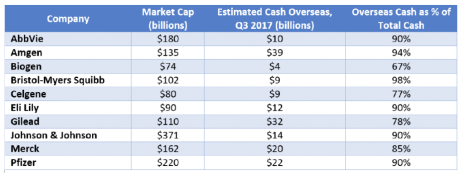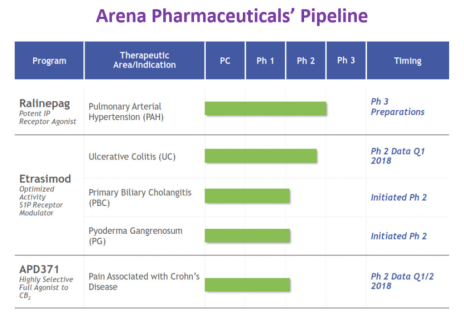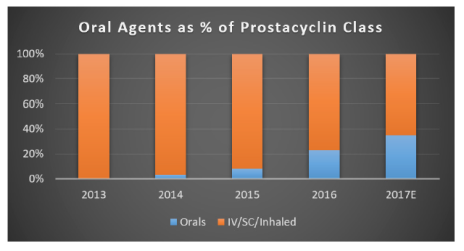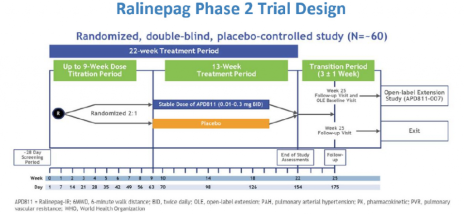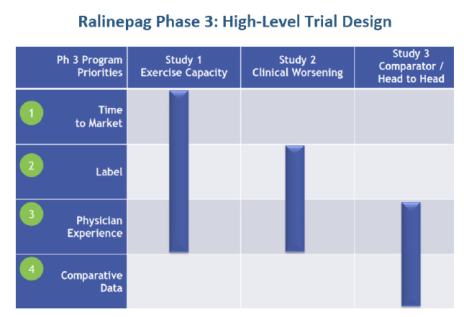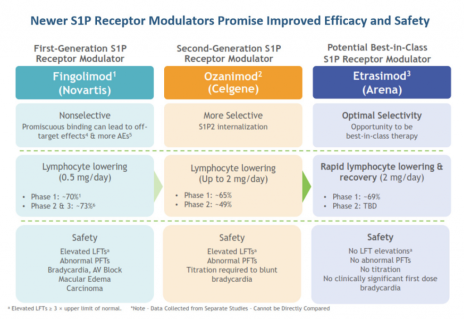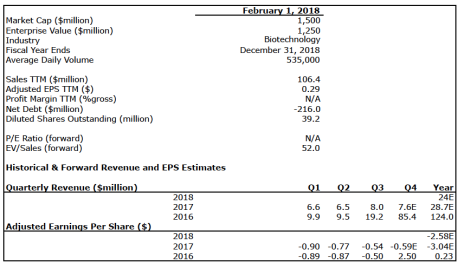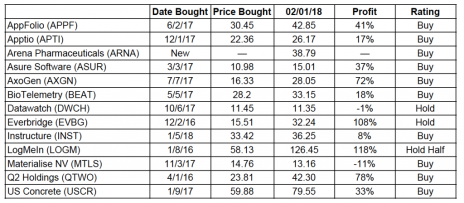Today’s stock candidate is a promising small-cap biotech with two high-potential drug candidates, each of which could develop into a billion-dollar asset.
Cabot Small Cap Confidential 225
[premium_html_toc post_id="144042"]
THE BIG IDEA
Ever so slowly, biotech stocks are making a comeback.
The biotech index is up 7% year-to-date, and up 29% since the beginning of last year. Companies with good trial data and promising pipelines have garnered investors’ attention and their dollars.
The sector’s performance is slightly better than the broad market, suggesting that the painful memories of the 2015 meltdown have eased.
In hindsight, after a 370% rally from mid-2011 thorough mid-2015, it’s not surprising that biotech stocks went through a major correction. Back then, with an election year on the horizon, pricing pressures mounting and blockbuster drugs facing increased competition, the upside potential of many biotech stocks became outweighed by the downside risk.
That’s doesn’t appear to be the case anymore.
Yes, pricing pressures remain, and they are likely to persist as biosimilars and pharmacy benefit managers (PBM) assert pressure on drug manufacturers. And in the large-cap biotech space, growth continues to trend down, along with valuations.
But on the flip side, there are numerous positive trends taking shape that are good for the industry, and especially for small-cap biotech stocks.
First, there is a lot of exciting innovation taking place with early-stage (Phase 1 and Phase 2) drug candidates. This is helping to prime the pump for future product launches.
Second, the regulatory environment for drug approvals has become more constructive. And many companies have potentially significant trial data releases in 2018 that can act as catalysts for share prices.
Then there’s tax reform. A much lower corporate tax rate (21% versus 35%) means potential acquirers have more cash to devour promising up-and-coming biotech stocks. And their cash position becomes that much more attractive when you factor in repatriation. Large-cap biotech stocks are holding billions in overseas accounts (see table below). They can now bring this cash home (paying a 15.5% rate versus 35% previously) and acquire smaller players with promising assets that could help them return to growth.
It’s not wise to invest in small-cap biotech stocks (or any stocks for that matter) purely based on M&A potential. But it has traditionally been an added incentive.
Of course, the best buyout candidates will be those with the most potential to develop winning drugs on their own. And that means investors should look for small-cap biotech stocks that stand out from the crowd.
Things to look for include validated mechanisms of action, promising pre-clinical and clinical data, favorable regulatory pathways, well-designed trials, less competitive markets (i.e., pricing power) and seasoned management teams.
Over the last couple of months, I’ve been assembling a list of small-cap biotech stocks that check most of these boxes (and more).
One has risen to the top, given what appears to be a high probability of success with two drug candidates that serve high unmet needs. Additional positives include near-term potential catalysts, adequate funding and attractive M&A potential.
This stock isn’t for the faint of heart. But if you can be disciplined enough to average in over time, I think you’ll find a lot to like about today’s recommendation.
THE COMPANY/PRODUCT
Arena Pharmaceuticals (ARNA) is a biopharmaceutical company that develops novel, small-molecule drugs with optimized receptor pharmacology designed to work across a wide range of therapeutic areas. The company has chosen to optimize its drug candidates to selectively target certain receptors found on cells in humans. It believes this approach will allow its drug candidates to address diseases more effectively, while limiting negative side effects. Currently, Arena is focused on developing first and/or best-in-class treatments for which it owns global commercial rights.
Its three most advanced investigational clinical programs are (1) ralinepag for pulmonary arterial hypertension (PAH), (2) etrasimod for ulcerative colitis (UC), pyoderma gangrenosum (PG) and primary biliary cholangitis (PBC) and (3) APD371 for pain associated with Crohn’s disease.
I’ll get into details on these drug candidates in a minute. But first, a little about Arena’s history.
Biotech investors may be familiar with the Arena Pharmaceuticals from a few years ago. That Arena was a story dominated by the obesity drug, Belviq (lorcaserin). Back in 2012, Belviq became the first weight-loss treatment in 13 years to gain FDA approval. Upon news of the approval, shares of Arena soared. And in the following years Arena manufactured the drug, which was marketed and distributed in the U.S. by its partner, Eisai.
The product proved to be a disappointment and failed to hit early sales forecasts of over $1 billion a year. The challenges weren’t specific to Arena—other weight-loss drugs also failed to hit targets. Arena slashed costs, cut its payroll, and at the request of the board of directors, its then CEO, Jack Lief, stepped down. He was replaced by an interim CEO.
On May 11, 2016, Amit Munshi stepped into the president and CEO role. He has helped steer the nimbler version of Arena toward developing drugs for auto-immune diseases, PAH and pain. Auto-immune medications have been shown to be particularly valuable, as evidenced by Celgene’s purchase of Receptos in 2015 for $7.3 billion. Receptos was working on ozanimod, an oral drug that was in a Phase 3 trial for relapsing multiple sclerosis (MS) and ulcerative colitis (UC).
Today, Arena has a drug candidate in a Phase 2 trial that could challenge ozanimod in the UC market.
New senior management then came on board in early 2017. Today, roughly 90% of Arena’s management team and 80% of the company’s staff is new.
Arena has also recently sold global rights to Belviq to Eisai for roughly $100 million, consisting of
$23 million in cash, and over $80 million in Belviq-related costs. It retained royalty rights of 9.5% to 18.5% depending on annual global net sales, but clearly the focus had shifted to the future, not the past.
In other words, the Arena of today is a very different company than the Arena of a few years ago.
Let’s take a look under the hood.
Arena’s Drug Candidates: Executive Summary
Arena is focused on advancing wholly-owned assets with big market potential that could become best-in-class treatments.
Ralinepag
Ralinepag currently drives around 75% of Arena’s value, and the drug candidate is the company’s most advanced compound. Arena has obtained orphan drug designation from the FDA for ralinepag for the treatment of pulmonary arterial hypertension (PAH). And promising Phase 2 data suggests potential best-in-class qualities in the rapidly-expanding oral prostacyclin class, which could develop into a multi-billion class.
Trial data for ralinepag showed both encouraging efficacy, and differentiation from market leader Uptravi (owned by Johnson & Johnson). Phase 3 development plans are in process, and while first revenue for the candidate (should it get that far) isn’t expected until 2021, potential to grab 50% market share (maybe more) with peak sales potential of $1 billion is likely to keep investor attention high. Current probability of success (PoS) is estimated at roughly 60%. Once the Phase 3 trial design is better articulated, this could creep up, adding value to the asset (and Arena’s stock).
Etrasimod
Etrasimod is Arena’s second most promising asset and has a validated mechanism of action (S1P modulation). Second-generation agents in this class (including etrasimod) appear likely to have fewer negative side effects than first-generation products, and have the potential to target multiple indications with high value and/or high unmet needs.
The market is currently looking forward to Phase 2 data (expected in Q1 2018) in ulcerative colitis (UC), a promising but competitive market where Celgene’s ozanimod looks to be a major product. Results from etrasimod’s Phase 2 trial will give us valuable insights into the drug’s efficacy and help clarify etrasimod’s potential to expand into pyoderma gangrenosum (PG) and primary biliary cholangitis (PBC). Investors don’t appear to have assigned much value to etrasimod (maybe 15% of Arena’s value), which suggests favorable efficacy data has the potential to significantly move shares.
APD371
Arena is developing APD371 for treatment of abdominal pain in patients with Crohn’s disease. Arena’s management said there are currently no non-opioid drugs developed for visceral pain (inflammatory bowel disease (IBD), pancreatitis, etc.), and that the high selectivity of APD371 might both decrease off-target activity, while proving effective for treating visceral pain. Very little value has been assigned to APD371, but that could change depending on Phase 2 data, which is expected in the first half of 2018.
Partnered Assets
Arena currently receives royalties (ranging from 9.5% to 18.5%) and product supply purchase revenue from sales of the weight-loss drug Belviq (licensed to Eisai).
The company is also partnered with Axovant (AXON) in the development of nelotanserin, which is being studied in Phase 2 trials of Lewy body dementia (visual hallucinations and REM sleep behavior disorder). Axovant is responsible for funding development and commercialization of the drug candidate, and Arena is eligible to receive up to $42 million. This is a long shot, but you never know!
Deep Dive on Arena’s Two Most Valuable Assets
Ralinepag: The PAH Market
Pulmonary arterial hypertension (PAH) is a rare form of high blood pressure occurring in the pulmonary arteries, which flow from the heart throughout the lungs. These arteries get constricted, which causes the heart to work harder than necessary, which in turn, drives up blood pressure. PAH is a progressive disease that can take a while to show up as symptoms—including shortness of breath, dizziness, fatigue and swelling in the limbs—are common to other conditions and are often dismissed away. Treatment is critical as the longer one goes without addressing the condition, the worse it gets.
There are three class of drugs currently used for PAH treatment: prostacyclins, endothelin receptor antagonists (ERAs) and phosphodiesterase-5 (PDE-5i) inhibitors/soluble guanylate cyclase stimulators.
Prostacyclins are the oldest approved class for treating PAH (over 20 years of use) and are still considered the gold-standard therapy. Within this class, adoption of oral prostacyclins has been growing rapidly (compared to inhaled and infused prostacyclin alternatives) over the last couple of years, driven by Actelion’s (acquired by Johnson & Johnson in early-2017) introduction of its second-generation PAH therapy, Uptravi.
After just their fourth year of availability, oral prostacyclins are estimated to hold roughly 35% of the market and are expected to generate around $730 million in annual sales in 2017, up almost 80% over 2016.
Market analysts believe patients will still need infused prostacyclin therapy, especially for late-stage patients, but that treatment approaches are gradually moving toward more aggressive front-line treatment using a combination of oral therapies.
The AMBITION study from a few years ago paved the way for this, and Johnson & Johnson’s ongoing TRITON study (results due in 2019) is investigating the benefits of a triple oral combination (ERA, PDE-5i, oral prostacyclin/Uptravi) in the front-line setting. Should TRITON show that oral prostacyclins are effective early on, this class could assume some of the roughly $3 billion in global annual sales occupied by the ERA class. That would be good for ralinepag.
Part of the attraction for investors is that the oral prostacyclin class carries a relatively high price point of $150,000 to $180,000 a year, versus $100,000 for an ERA. Should ralinepag make it to market (estimated at 2021 in the U.S. and 2022 in the EU) the treatment could reach $1 billion in global annual sales by 2030, assuming U.S. pricing of around $165,000/year, and half that in the EU. After that, a generic version of Uptravi is likely to hit the market and change competitive/pricing dynamics.
Ralinepag: Billion-Dollar Potential
Ralinepag’s Phase 2 results (twice-daily formulation versus placebo, 61 patients, 22-week treatment period) are arguably best-in-class and showed better in vitro characteristics than Uptravi’s active metabolite (MRE-269), including (1) reduction of vasoconstriction, (2) inhibition of smooth muscle cell growth and (3) inhibition of platelet aggregation. Ralinepag also has greater potency and a longer half-life (20 to 26 hours) than Uptravi (8 hours), meaning potentially lower peak-to-trough ratio (approximating continuous IV infusion), and the possibility of a once-a-day extended release (XR) formulation.
The Phase 2 study achieved its primary endpoint, with a significant improvement in pulmonary vascular resistance (PVR) and increase in six-minute walk distance (6MWD) to 36.2m (Uptravi Phase 2 showed 24.6m) in the ralinepag arm. The safety profile was more-or-less in line with other prostacyclin therapies.
So far, it appears clear that ralinepag is effective and well-tolerated. We now move on to the Phase 3 trial, which is currently being designed. Investors need to buckle in for a couple of years as Phase 3 trials in PAH have proven to be somewhat long. While we hope for eventual success (currently estimated at roughly 60%), there are several important milestones that can add value to ralinepag (and therefore Arena’s stock) along the way.
First up are more details on the Phase 3 trial design, which should be forthcoming in the first half of 2018. Management’s latest update on the trial’s design came at the JP Morgan Healthcare Conference on January 10.
What we know now is that management wants to (1) get the product to market reasonably soon, (2) expand the label over time, (3) get the product into the hands of as many clinicians as possible and (4) gather comparative data (likely versus Uptravi) so it can definitively prove that Arena has a best-in-class compound.
We also expect the trial to incorporate three studies:
(1) a study in exercise capacity (6MWD, cardiopulmonary exercise test (CPET), etc.), (2) a clinical worsening (outcomes) trial and (3) a comparative study (versus Uptravi and Orenitram). The trial could also incorporate a once-daily, extended release dosing, which would be a significant differentiator (i.e., add value to the asset).
Remember, Arena is trying to develop a drug with billion-dollar potential, so this Phase 3 trial design is a big deal.
The studies should all start at about the same time later this year. Stay tuned for further details, potentially coming by the end of March!
Etrasimod: Underappreciated S1P Receptor Modulator
Etrasimod is a sphingosine-1-phosphate (S1P) receptor modulator currently under evaluation for multiple autoimmune diseases, including ulcerative colitis (UC), pyoderma gangrenosum (PG) and primary biliary cholangitis (PBC).
S1P modulation has the potential for effective treatment in over 100 conditions, which is part of why Celgene was willing to shell out $7 billion to acquire Receptos and its S1P modulator, ozanimod.
It’s believed that binding modulators to S1P receptors can lower the level of circulating lymphocytes and reduce inflammation, but first-generation products (i.e., the MS drug Gilenya (fingolimod), which is owned by Novartis) carry significant safety concerns (elevated liver enzymes, bradycardia, macular edema and impairment of pulmonary function) as they non-selectively target S1P receptor subtypes 1 through 5 (see table below for details).
Second-generation products, including Celgene’s ozanimod and Arena’s etrasimod, are more selective, targeting a subset of S1P receptors. Theoretically, this should cause fewer adverse side effects.
In other words, with etrasimod, Arena is trying to ditch the elephant gun in favor of a sniper rifle.
Etrasimod targets S1P receptors 1, 4 and 5, and avoids S1P receptors 2 and 3, meaning, theoretically, a reduced risk of cardiac and pulmonary toxicities.
Arena’s work on etrasimod is early-stage. But so far, so good. Preclinical studies showed it to be well-tolerated at doses up to 3.0 mg, lead to a reduction of lymphocyte counts, and work quickly (53% lymphocyte reduction at day 3, versus 15% reduction at day 3 for ozanimod).
Etrasimod Phase 2 in Ulcerative Colitis (UC): Potential Near-Term Catalyst
Ulcerative colitis affects roughly 600,000 people in the U.S., and roughly 50% of them are considerate moderate/severe cases. Initial treatments include mesalamine and/or prednisone, but aren’t that effective. Some patients move on to immunosuppressive therapy and/or anti-TNFs, but these are expensive treatments with adverse side effects.
Oral agents are desirable to patients, and current drug development trends point toward S1P modulators and JAK inhibitors holding the most promise. Pfizer sells a JAK inhibitor, Xeljanz, but it appears to come with significant side effects. This is one reason physicians are keyed in on safety as a critical hurdle for new drug adoption.
UC is a potentially lucrative, but competitive market. There are around 30 drug candidates in either Phase 2 or Phase 3 trials. And with trial patients cycling through many approved options it can be hard to get clean data. But with a UC market value of up to $5 billion a year, assuming annual treatment cost of around $30,000, there is room for multiple players.
Etrasimod’s Phase 2 trial in UC began in 2015 with 157 patients with moderate to severe UC. Efficacy endpoints are evaluated after 12 weeks of treatment, and include safety and tolerability, improvement in the 3-component partial Mayo score, response and remission rates, mucosal healing versus placebo, and dose response.
Data from the trial is due out in Q1 2018. And positive results could be a major catalyst for shares of Arena, potentially adding 35% to 50% to the value of the company (with downside of roughly 10% to 25%).
This upside potential exists because proof of efficacy and lymphocyte reduction increases the probability that etrasimod could be developed across a range of indications. Remember, Arena has two additional Phase 2 studies currently underway for PG, a rare skin disease affecting 1 in 100,000 people in the U.S., and PBC, a chronic liver disease affecting 40 in 100,000 people in the U.S.
Data should come in late-February or early-March. And if it is good, big decisions will need to be made. A Phase 3 trial would likely be long, expensive and competitive (lots of patients being sought after for lots of trials). And success might mean Arena starts to look for a partner or needs to raise capital sooner than expected.
Still, a positive result is, of course, better than a negative one! I’ll update you as soon as data from the Phase 2 UC trial comes out.
Arena’s Potential as an Acquisition Target
Arena appears to be a relatively attractive acquisition target, especially if ralinepag’s Phase 3 data looks good. It’s notable that Myogen, which developed Letairis, a PAH drug in the ERA class that debuted in 2007, was purchased by Gilead (GILD) for $2.5 billion in 2006. Gilead announced the acquisition roughly one year before the drug was approved. Like ralinepag, Letairis was somewhat differentiated by being a once-a-day oral (versus first-to-market Tracleer, which is twice-a-day). After 10 years on the market, Letairis has captured just under 50% market share. There’s also the potential to develop etrasimod into a major product with multiple indications.
The Business Model
Arena Pharmaceuticals is a drug developer and manufacturer. While it generates some revenue through licensing rights to previously developed drugs, its primary focus now is developing new drugs for which it owns global rights. It has a few collaborative relationships that add incremental revenue today.
The company has chosen to optimize its drug candidates to selectively target certain receptors found on cells in humans. It believes this approach will allow its drug candidates to address diseases more effectively, while limiting negative side effects.
If all goes according to plan, Arena will transition from a drug developer to a revenue-generating pharmaceutical company with multiple assets. Or, it will be purchased and become part of a larger organization.
The Bottom Line
Over the last nine months, Arena has generated revenue of $21.1 million (down 45% from the previous nine months). Of that, 37% came from product sales, 27% came from Eisai collaboration revenue, 18% came from a collaboration agreement with Boehringer Ingelheim, and the rest came from toll manufacturing agreements and other collaborations. With the terms of the Eisai Agreement amended, it’s likely royalties will trend down in the future.
That said, Arena isn’t attractive because of its royalty stream and/or collaborations, but because of the potential of ralinepag (primarily) and etrasimod. Successful development of these assets is key, and with roughly $280 million in the bank at the end of Q3 2017, Arena is well positioned to fund operations for the next year and then some. At this point, I see the next equity offering taking place in 2020, at which point the path forward will be much clearer and shares of Arena should be worth a lot more than they are today.
Below is a list of potential near-term catalysts. This is what we’ll be focused on. A best-case scenario is that data from the Phase 2 etrasimod trial is good, the Phase 3 ralinepag trial design checks all the positive boxes, and that early data for APD371 keeps that fire burning. In this scenario, Arena marches into the back half of 2018 with two multi-billion-dollar potential Phase 3 programs.
RISK
Drug Development is Risky Business: Drug development is a very expensive, time consuming, challenging and risky business. Drug candidates must first be discovered, then refined, then tested and evaluated through preclinical studies and clinical trials. If everything goes well, regulators may approve the drug candidates for sale. At that point, pricing must be determined and manufacturing supply agreements arranged. After several years on the market, generic versions can take over! But while there is a high rate of attrition from the failure of drug candidates to make it to market, those that do can rake in the cash. And their formulations can be modified to improve their efficacy, pricing power, or be extended to additional indications.
Ralinepag Phase 3 Failure in PAH: Given that ralinepag drives around 75% of the value of Arena, a failure in this trial would likely be devastating. A mixed result (i.e., trial success, but lack of differentiation from Uptravi) is also a risk (but far less damaging than an all-out trial failure).
Etrasimod Phase 2 Failure in UC: While the market isn’t expecting a lot from this trial (at this point), a negative outcome still limits Arena’s addressable market, and reduces the likelihood of expanding etrasimod to other indications.
Success in the FREEDOM-EV study, sponsored by United Therapeutics: This trial is exploring the efficacy of Orenitram in combination settings. The drug hasn’t had great commercial success due to tolerability challenges, but a positive trial result would likely help the drug maintain market share, which would mean a three-horse race should ralinepag reach the market (Uptravi, Orenitram and ralinepag). A negative trial result would be positive for Uptravi, and likely increase acquisition interest in Arena/ralinepag. Data is due out in the second half of 2018.
TRITON Triple-Therapy Failure: A disappointing result from Johnson & Johnson’s trial (results due in 2019) could limit the front-line potential of oral prostacyclins and therefore, limit the market potential of Arena’s ralinepag.
Manufacturing and Supply Risks: Arena needs to manufacture enough product to supply clinical trials now, and, potentially, to meet market demand for commercial production in the future.
End Market Demand Lower Than Expected: Success developing drug candidates is one thing. But as we’ve seen with Arena’s weight-loss drug Belviq, sometimes market demand falls short of expectations, other treatment options grab market share and/or pricing dynamics aren’t as favorable as previously expected.
COMPETITION
Arena’s primary competitors are companies with drugs on the market or in development that are designed to treat the same conditions and/or work with a similar method of action as Arena’s drug candidates. In the PAH market, oral prostacyclin class, Arena’s ralinepag competition includes Johnson & Johnson’s Uptravi, and United Therapeutics’ Orenitram. In the ERA class, we should keep an eye on Gilead’s Letairis, Johnson & Johnson’s Tracleer and Actelion’s Opsumit. In UC, Arena’s S1P modulator etrasimod is going up against Novartis’ Gilenya and Celgene’s ozanimod, as well as Pfizer’s JAK inhibitor, Xeljanz. There are roughly 30 additional drug candidates being developed for UC that are in Phase 2 and/or Phase 3 trials.
THE STOCK
Trading Volume: Arena Pharmaceuticals has a market cap of $1.47 billion and trades an average of 535,000 shares daily. That means roughly $20 million worth of stock trades each day. Our subscriber group won’t move this stock. Heavily traded days bring more than one million shares, and that’s happened six days over the last six months.
Historical Price: ARNA was a high flyer back in 2012 and 2013 after Belviq was approved. As the drug’s market potential dissolved, shares of ARNA fell. The stock consolidated in the 12.5 to 20 range through most of 2016 and 2017 as the new management team took over and steered the company in a new direction. Shares jumped to life and traded as high as 28 in July 2017 when positive Phase 2 ralinepag data in PAH was announced. The stock settled back to 20 in August after a $150 million secondary offering was announced. Shares held firm at that level and have been gaining altitude since, trading mostly above their 50-day line. Shares popped early in 2018 to reach a 52-week high of 41.92 but have pulled back modestly over the past three weeks to trade in the 33 to 40 range.
Valuation and Projected Price Target: Shares of ARNA are likely worth around 45 now (20% upside), factoring in a roughly 60% chance of ralinepag success, a 25% chance of etrasimod success, and assigning modest value to the company’s royalty stream, collaborations and early-stage assets. If everything goes well, the stock could be worth upwards of 70 in 2018 (85% upside) or as little as 20 if things start to fall apart. Let’s start with a 50 price target, which factors in mostly positive data in 2018, but enough question marks on ralinepag trial design and etrasimod Phase 2 trial results to keep a best-case-scenario off the table, for now.
Buy Range (next two months): Buying between the 50-day line at 34 and the 52-week high at 42 appears to be a good window of opportunity now. Over the next couple of days, purchases in the 36 to 40 range seem appropriate. I expect the stock to trade mostly in line with the broader biotech group until etrasimod Phase 2 data is released.
The Next Event: Management should announce etrasimod UC Phase 2 Data in late-February or early-March. Fourth-quarter 2017 results should be out in the second week of March. It’s possible these two events will be combined.
Arena Pharmaceuticals (ARNA) Financials
Arena Pharmaceuticals (ARNA 39) |
UPDATES ON CURRENT RECOMMENDATIONS
Due to the nature of the stocks recommended, it is to your advantage not to share these recommendations.
Buy means accumulate shares at or around the current price.
Hold means just that; hold what you have. Don’t buy, or sell, shares.
Sell means the original reasons for buying the stock no longer apply, and I recommend exiting the position.
Sell a Half means it’s time to take partial profits. Sell half (or whatever portion feels right to you) to lock in a gain, and hold on to the rest until another ratings change is issued.
The broad market pulled back this week but, thus far, the damage to small caps has been limited. The S&P 600 Small Cap Index is still trending above its 50-day line.
It might be a little touch and go here for a while with Treasury yields moving higher. But we’ll take it one step at a time, and not make any bold predictions about the market’s future direction.
Without any earnings from portfolio stocks this week, news flow was light. That will change next week as earnings results start to pour in. For now, all ratings are the same as they were last week. And I’ll update them as we learn more about how the fourth quarter went, and, more importantly, how 2018 is shaping up for our stocks.
Updates
AppFolio (APPF) pulled back to its 50-day line this week but has held firm there. Provided the company reports a decent quarter (date not yet announced) and gives some indications for future plans, there’s considerable upside potential. Shares could leap back near their 52-week high (just over $50) given that AppFolio is turning into a profit machine. Keeping at buy. BUY.
Apptio (APTI) earnings are due out next Monday and I expect this to be a significant update, for all the reasons I detailed last week. Shares look good heading into the report, and I’m keeping at buy. BUY.
Earnings: February 5
Asure Software (ASUR) is trending in the right direction as well and appears comfortable above its 50-day line. Volume has trailed off since the big breakout in March. But that’s not too surprising given the small size and likelihood that investors are awaiting the next quarterly result (date unannounced) before making their next move. Keeping at buy. BUY.
AxoGen (AXGN) slid a few points early in the year but has stabilized right above its 50-day line. As I’ve been saying, the upcoming earnings release isn’t going to be a major event since the company already pre-released. Perhaps more interesting will be management’s presentation at the LEERINK Partners Healthcare Conference next Wednesday. I’ll update you on any developments next Friday. BUY.
Earnings: February 28
BioTelemetry (BEAT) dipped a little this week but not enough to get concerned about. An earnings date hasn’t been announced yet. For 2017, the market is currently expecting revenue growth of 36% (35% in 2018) and flat EPS growth (up 42% in 2018). As I mentioned last week, the company should see a significant benefit from the new 21% tax rate for 2018. BUY.
Datawatch (DWCH) announced an acquisition this week. The company has paid $24.5 million ($10 million debt, $14.5 million cash) to acquire Angoss Software, a Toronto-based provider of data intelligence solutions, including enterprise data preparation, predictive analytics, and visualization software. Its modeling and visualization tools are used for customer segmentation, customer churn, credit risk scoring and fraud detection. Clients come from financial services, telecommunications and retail industries.
Datawatch says the two companies share several clients, that over 80% of Angoss’ revenue is recurring, and that the acquisition will help it expand into the data science platform market, which is roughly 3-times as large as Datawatch’s current self-service data prep market, and is growing at around 11% a year. Angoss brings revenue of $10.6 million from 2017, implying the combined company would have $48.2 million in revenue over the last twelve months. We don’t know Angoss’ growth rate.
On the surface, this sounds like an interesting acquisition. I like that the software can be integrated quickly and that the deal will be accretive on a non-GAAP basis in fiscal 2019. Thus far the market’s reaction has been muted, probably because this will take some digging into, as well as a quarter of results, before we can really assess how this changes things. I’ll update you more after I dig deeper. For now, continue to hold. HOLD.
Earnings: DONE
Everbridge (EVBG) was moved to hold last week and is staying there for the time being. I accidently stated that earnings are due out tomorrow – they’re not. Earnings will come out on February 21. The market is currently expecting 2017 revenue growth of 35% (to $103.7 million) and EPS loss of $-0.24. Current consensus for 2018 is revenue growth of 26.3% (to $131 million) and EPS loss of $-0.21. I think revenue estimates look good, as well as EPS for 2017, but that there’s some downside risk to 2018 EPS estimates because of the recent convertible offering. HOLD.
Earnings: February 21
Instructure (INST) will report the week after next, and current consensus calls for 2017 revenue growth of 41% (to $156.4 million) and EPS loss of $-1.20. The market will be particularly interested in progress selling the new Corporate LMS solution, Bridge, an update on the hiring of a Chief Revenue Officer (CRO), as well as trends in non-recurring professional services revenue and revenue from early implementations. The stock is making a run at its 52-week high and is still a buy. BUY.
Earnings: February 12
LogMeIn (LOGM) is also making a run at its 52-week high. Yesterday the company announced a 20% increase in its dividend, from $0.25 to $0.30. This is an incremental positive, and with the increase the stock currently yields around 1%. Keep holding. HOLD HALF.
Earnings: February 15
Materialise (MTLS) is bouncing around on no new news. We don’t have an earnings date yet. Keeping at buy. BUY.
Primo Water (PRMW) No Update. Sold two weeks ago for a 47% gain. SOLD.
Q2 Holdings (QTWO) has gone on a heck of a run over the past two weeks and is now back above $40 and within a couple dollars of its 52-week high. Interestingly, the stock’s move has been the opposite of what financial stocks have done, which I attribute to shares moving too low in December (from $44 to $37) on no company-specific negative news. BUY.
Earnings: February 14
U.S. Concrete (USCR) dipped back below its 50-day line yesterday on relatively high volume, perhaps because President Trump appears to have shelved his planned infrastructure bill in favor of more pressing matters. The stock held firm above $75, as it did when shares retreated in December and January. No earnings date yet. BUY.
Please email me at tyler@cabotwealth.com with any questions or comments about any of our stocks, or anything else on your mind.
Next Cabot Small-Cap Confidential issue is scheduled for March 2, 2018
Cabot Small-Cap Confidential is published by the Cabot Wealth Network, an independent publisher of investment advice. Neither the corporation nor its employees are compensated in any way by the companies whose stocks we recommend. Sources of information are believed to be reliable, but they are in no way guaranteed to be complete or without error. Recommendations, opinions or suggestions are given with the understanding that subscribers acting on information assume all risks involved. Copyright © 2018 - COPYING AND/OR ELECTRONIC TRANSMISSION OF THIS NEWSLETTER IS A VIOLATION OF THE U.S. COPYRIGHT LAW. For the protection of our subscribers, if copyright laws are violated by any subscriber, the subscription will be terminated.
[premium_html_footer]


